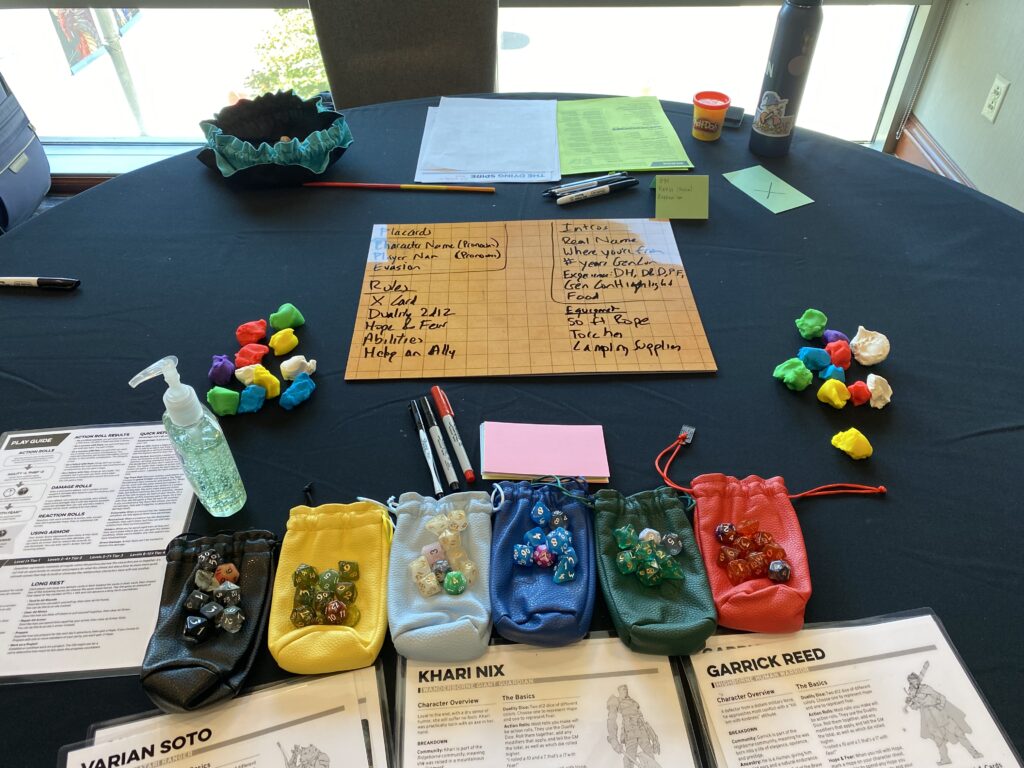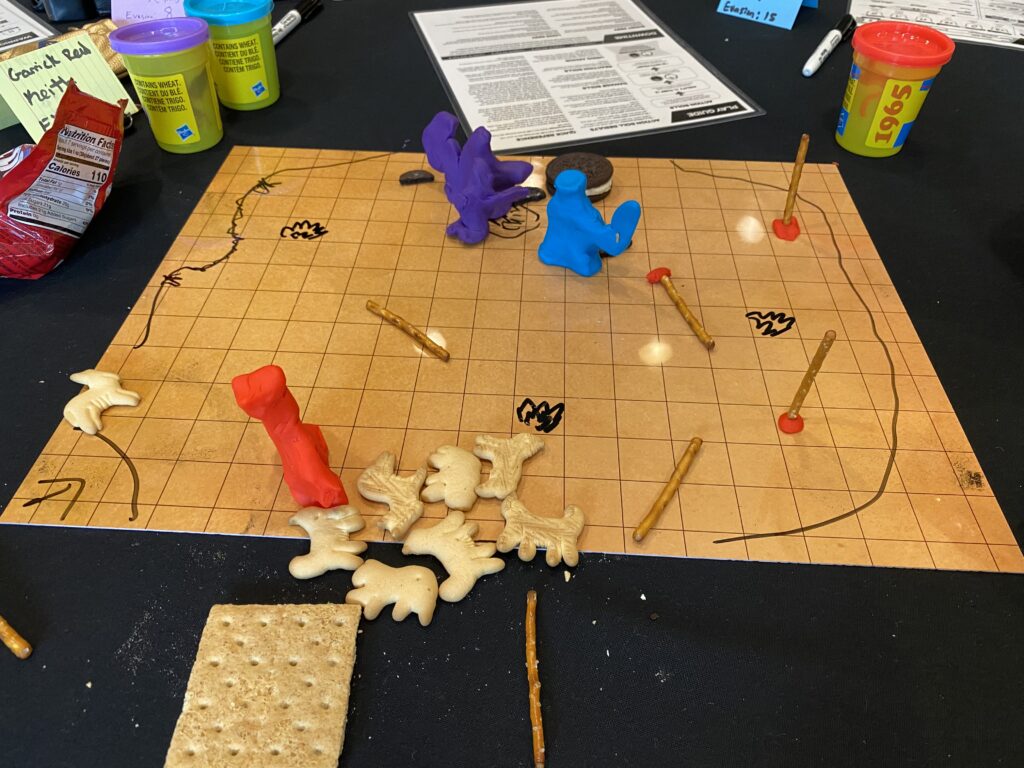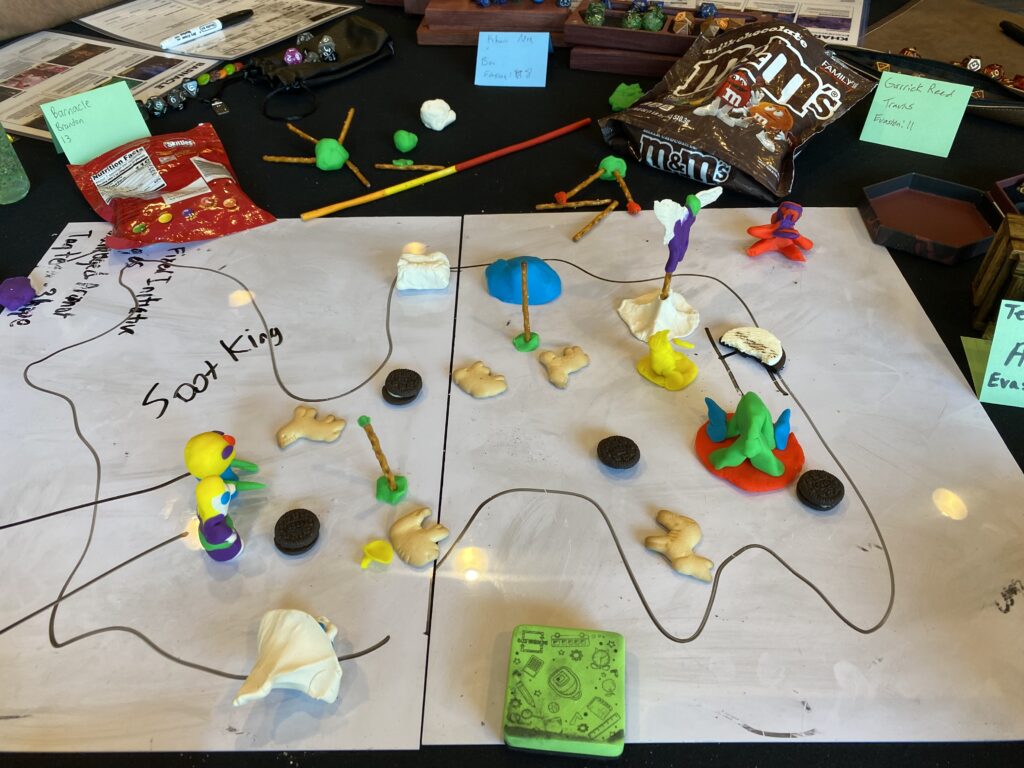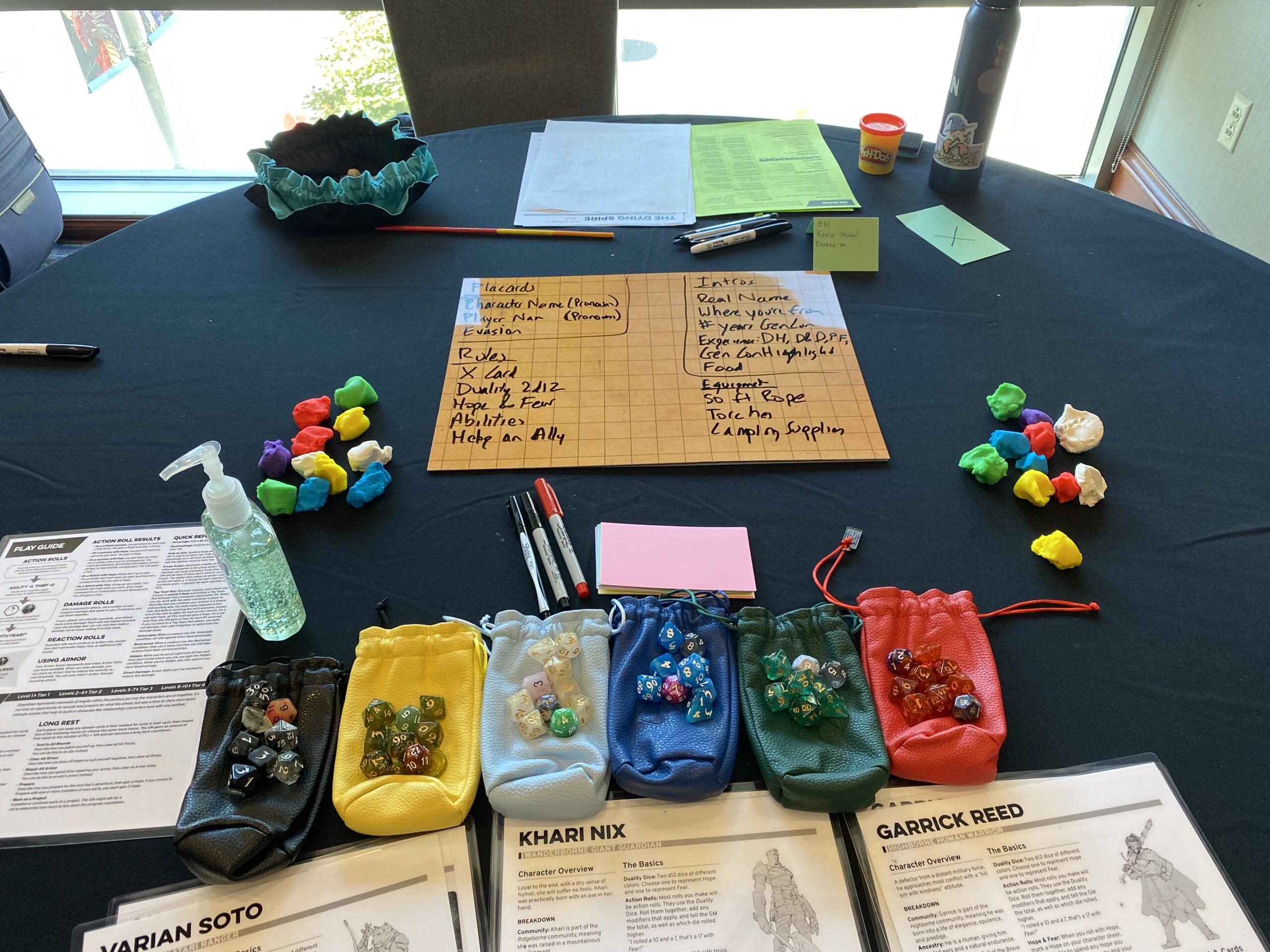At Gen Con this year, I had the opportunity to run a new Daggerheart adventure for Darrington Press. I previously wrote about some takeaways from the experience, but I also wanted to share how I approached running the games.
I have an unhealthy obsession with planning and logistics. I spend an unnecessary amount of time optimizing how I make dinner so I don’t waste a moment. That’s how I end up boiling water, preheating the pan, chopping onions, and microwaving peas at the same time and losing my mind trying to track all of that.
Which is all a perfect analogy for GMing. When I’m in the game, I’m managing the plot, players, upcoming encounters, and rules at the same time. That’s unpredictable chaos (and also kind of my jam).
But at least I can plan a strong start, which is the point of this blog post. Between past con experience and bringing limited supplies with me, I adopted a very specific process for getting a game started. Let’s start with the stuff.
Physical layout
Before the players arrived, I took 10-15 minutes to setup the physical space for my game. Here’s the table from a player’s perspective as they walk up.

Character Sheets
Darrington Press provided laminated pregen character sheets like those in the Quickstart adventure, including:
- cover sheet with background
- the character sheet itself
- a printed page of the ability cards
- the slideouts
I arranged all of the character sheets at the front of the table. As players walked up, I (genuinely) excitedly greeted them and asked them to pick a character before sitting down.
This approach has the downside of not allowing the players to coordinate and negotiate between all options. However, I found that most players ultimately aren’t too picky, and it helped to get everyone settled faster this way.
I encouraged the players to look over their character sheets while we waited for everyone to settle in. I demonstrated with the slideouts over and over again (going “Ooooh, Aaaah” every time like it’s the first time) since it’s a great way to gradually absorb the rules without explicitly teaching.
Dice
Darrington Press also provided a full set of polyhedral dice along with another set of unique Hope and Fear dice. I invited players to use their own unlucky dice if they had them. At each session, usually one or two players would take the provided dice while all of the other dice goblins sifted through to find the wildest d12s.
Tent card
Other GMs must have done this before me, but I’m almost certain I separately came up with one of my best innovations: the Tent Card.
Players fold a notecard in half and write the following on it:
- Character name (and pronouns)
- Real name (and pronouns)
- Evasion score
And then stand it up in front of them. In the picture above, I have my yellow Tent Card with
- GM
- Kevin
- ∞
Especially at a con, having that information makes every interaction way smoother. There’s no guessing or awkward forgetting: just look and keep playing.
As a GM, it’s huge to not have to ask players for their Evasion over and over again. I usually still acknowledge it by saying something like, “The salmon-chipmunk got a 17 to hit to beat your 13” so they know I’m not fudging dice. Also they can react if necessary.
For 5e DMs, I typically have players write their Armor Class and Passive Perception. With that, their PP is actually passive.
Miniatures
Some GMs brought beautiful 3d printed or pre-made miniatures for their players. Darrington Press provided the paper standees.
I chose play dough.
Maybe this is just dad brain, but for a one-shot, I thought it would be more fun for players to actually make their minis on the spot.
For the first game, I set out the containers, and that actually didn’t work well. Players just took a big hunk of one color and made puffy, monochromatic shapes.

On subsequent games, I tore the play dough into several smaller pieces on both sides of the table. This small manipulation actually changed things because players started to mix and match colors and make detailed minis.

Introductions
Once all of the players were seated, we did introductions. The questions are:
- Your name
- Where you’re from
- How many years you have been at Gen Con
- What your experience with Daggerheart, D&D, Pathfinder, or other TTRPGs is
- Best things in the exhibit hall
- Best food in Indianapolis
The first three questions are for icebreakers. The last two questions were for myself as a Gen Con newbie trying to get the lay of the land.
Question four was the really important one. That one helped me understand the player’s previous experience and how much I needed to teach. Honestly, at Gen Con, I felt like most of the players had more TTRPG experience than me, so that was easy to figure out.
I keep the rules short
In my opinion, one of the most beautiful things about playing most TTRPGs is that you don’t need to know how to play TTRPGs. The rules help, but make-believe is quite natural, and it’s regrettable that many adults forget how to do it.
As such, I typically prefer to teach as few rules as possible and let creativity lead.
Since most TTRPGs are also cooperative, players are usually quite forgiving about learning rules on the fly. Unlike a competitive board game, you’re not going to be “behind” because you didn’t understand something to begin with.
Furthermore, at a convention like Gen Con, most players know how to play TTRPGs in general, and the knowledge transfers quite easily.
Here’s my checklist of Daggerheart rules that I teach to start the game:
- Use the slide outs (oooh, aaah) to guide you through your character sheets
- The X Card – I have never had a player invoke the X card at a con, but I never want to forget it
- 2d12 Duality dice
- Hope and fear. Hope is primarily spent on abilities that ask for it, using experiences, and helping allies
- Abilities – I don’t explain any of the players’ abilities. I only say that
- 1. you can use them as often as you want unless it says otherwise. This addresses D&D assumptions about limited spell slots
- 2. “temporarily” means “until the end of the scene” or “until I spend fear”
This explanation takes less than 5 minutes, and I don’t bother with combat rules to start.
When a fight breaks out during the session, I explain
- No fixed initiative
- Ranges – you can move within close for free
- Damage and armor
- Tag team – it’s so important to the game, and otherwise hard to find in the rules
Question and Connections
Then the players finish by filling in their characters. There was another round of character introductions, where players would say:
- Character name
- 2 sentence description of their character
- Read their question aloud and answer it
After everyone did that, the players fill in their Connection questions.
Honestly, I thought I was going to need to prod more to get players talking, but for all of my sessions, they just launched straight into filling it out. The pregen characters lended themselves to natural connection between them.
And then I would start the game!
Final Thoughts
There are plenty of way to enjoy cons, but despite the scale, it can feel very intimate. When I was in the exhibit hall at Gen Con, I felt like I was there with 70,000 people. However, I spent most of my waking con hours running games, and that’s a table of six players.
I have my own GM style. Each of the other five GMs in that room with me at any time have their own styles. And every configuration of players is different. And where they decide to take it is different. So even though we’re all starting from the same packet, we each bring away a unique experience every time, and that’s something special.

Leave a Reply